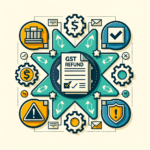How to Use GST Data Analytics to Improve Compliance and Returns
For most Indian small business owners, the Goods and Services Tax (GST) system can feel like a constant source of stress. The cycle of filing returns, managing compliance, and the looming fear of receiving a tax notice can be overwhelming. But what if the key to mastering GST was hidden in plain sight, within the data you already generate every month? The solution lies in a powerful approach called GST data analytics. This is the process of examining your GST filings—your sales, purchases, and tax payments—to uncover critical insights, identify potential errors before they become costly problems, and make smarter financial decisions for your business. This comprehensive guide will provide you with actionable GST compliance strategies for businesses, explaining exactly how to use your own data to simplify compliance, maximize your Input Tax Credit (ITC), and truly enhance GST returns India.
What is GST Data? Uncovering the Goldmine in Your Filings
Every time you file a GST return, you are creating a digital footprint of your business’s financial health. This data isn’t just a set of numbers for the government; it’s a rich source of information that, when analyzed correctly, can reveal the story of your cash flow, sales performance, and supply chain efficiency. Understanding the components of this data is the first step toward harnessing its power.
The Core Components of Your GST Data
Your GST data is primarily composed of a few key documents that you interact with regularly. Think of them as the building blocks of your financial transparency.
- GSTR-1 (Outward Supplies): This is your digital sales ledger. It’s a detailed, invoice-level record of all the goods you’ve sold and services you’ve provided during a tax period. This data tells the government, and you, exactly where your revenue is coming from.
- GSTR-2B (Auto-drafted ITC Statement): This is one of the most crucial documents for your cash flow. The GST portal automatically generates this statement for you based on the GSTR-1 filings of all your suppliers. In simple terms, it shows the Input Tax Credit (ITC) that is officially available for you to claim, representing the tax you’ve already paid on your business purchases.
- GSTR-3B (Summary Return): This is the monthly summary return where everything comes together. You declare your total sales, total purchases, and the ITC you are claiming (based on your GSTR-2B and purchase records), and you pay the resulting net tax liability.
- E-way Bills & E-invoicing Data: For businesses that meet certain turnover thresholds, this data is also critical. E-way bills track the movement of goods, a process detailed in the Guide to GST E-Way Bill Generation, while e-invoices are a system for real-time reporting of B2B invoices to the GST portal. This data must be in perfect alignment with what you report in your GSTR-1.
Why This Data is More Than Just a Compliance Task
Viewing these filings as mere compliance chores is a missed opportunity. Your GST data provides a complete financial X-ray of your business operations. It shows who your best customers are, which states you sell to the most, which suppliers are timely with their filings, and where your money is going. By actively using data analytics for GST returns, you transform a mandatory, often tedious, task into a strategic business advantage. Instead of just reporting numbers, you begin to understand them, question them, and use them to drive growth, efficiency, and profitability. This proactive approach turns your tax compliance from a defensive necessity into an offensive business strategy.
Key Benefits of Applying GST Data Analytics in India
Adopting a data-driven approach to your GST compliance offers tangible benefits that go far beyond just avoiding penalties. It empowers you to take control of your finances, reduce risks, and make more informed decisions. By implementing GST data analytics in India, businesses can unlock significant value and build a more resilient financial foundation.
Proactive Error Detection and Risk Reduction
The GSTN (Goods and Services Tax Network) is becoming increasingly sophisticated, using its own algorithms to flag discrepancies in returns. The most effective way to avoid a notice is to find and fix errors before the system does. Analytics helps you spot common red flags, such as a mismatch between the sales you declared in your GSTR-1 and the summary figures in your GSTR-3B. It also highlights critical discrepancies between your own purchase records and what appears in your GSTR-2B, which can prevent you from claiming incorrect ITC and facing future demands for tax, interest, and penalties. The practice of data analytics for GST compliance is fundamentally about maintaining clean, consistent, and accurate data. This diligence significantly lowers your business’s risk profile in the eyes of the tax department, making you less likely to be selected for scrutiny or audit. Learning How to Correct Errors in Your GST Returns is a vital skill this process enhances.
Maximizing Your Input Tax Credit (ITC)
Input Tax Credit is the lifeblood of a GST-registered business; it directly reduces your tax outgo and improves your working capital. However, many businesses fail to claim the full ITC they are legally entitled to, simply because of manual errors or a lack of oversight. A systematic, monthly reconciliation of your purchase register with your GSTR-2B is the single most important activity to maximize ITC; understanding ITC Reconciliation: Importance and Best Practices for Businesses is key. Data analytics automates and refines this process, ensuring you match every invoice and claim every eligible rupee. Furthermore, analytics can quickly identify non-compliant suppliers—those who have collected GST from you but have failed to file their own GSTR-1. When a supplier doesn’t file, their invoices won’t appear in your GSTR-2B, and your ITC gets blocked. Analytics pinpoints these specific suppliers, allowing you to follow up with them proactively to unblock your rightfully-earned credit and directly enhance GST returns India.
Improving Business Decision-Making
Beyond compliance, your GST data is a treasure trove of business intelligence. By analyzing sales data from your GSTR-1, you can easily identify trends that might otherwise go unnoticed. You can discover your top-performing products or services, see which geographical regions (states) are driving the most revenue, and even spot seasonal sales patterns that can inform your marketing and inventory management strategies. On the purchase side, analyzing your data can reveal your total spending with key vendors. This information is invaluable when negotiating better payment terms, bulk discounts, or service level agreements. This strategic use of data transforms your finance function from a cost center into a value-generating part of your business.
A Practical Guide to Implementing GST Data Analytics
Getting started with GST data analytics doesn’t require a degree in data science. It’s a logical process that any business owner can begin implementing with the right approach and tools. Follow these steps to build a robust framework for analyzing your GST data.
Step 1: Consolidate Your Data Sources
The first step is to gather all your information in one place. Your data lives in two main locations: your internal records and the government portal. You need to pull comprehensive reports from your accounting software (like Tally, Zoho Books, or QuickBooks) that detail all your sales and purchase invoices for the tax period. Next, you need to log in to the official GST Portal and download the relevant machine-readable files for GSTR-1, GSTR-2B, and GSTR-3B. Having both your internally recorded data and the government-held data is essential for the next step: reconciliation.
Step 2: Perform the Three Critical Reconciliations
Reconciliation is the heart of GST data analytics. It’s the process of comparing different data sets to ensure they match perfectly. Any difference is a potential error that needs to be investigated and corrected. These reconciliations are fundamental tax compliance improvement techniques.
- GSTR-2B vs. Purchase Records: This is the most vital reconciliation for protecting your cash flow. You must compare every invoice in your purchase register with the entries in your GSTR-2B. The goal is to match invoice numbers, dates, taxable values, and tax amounts. This process ensures you are not missing any eligible ITC and that you aren’t claiming credit for an invoice your supplier hasn’t reported.
- GSTR-1 vs. GSTR-3B: This is a crucial check for outward supply consistency. The total taxable sales and tax liability you report in your summary GSTR-3B must match the detailed, invoice-level data you submitted in your GSTR-1. A mismatch here is a major red flag for tax authorities, suggesting either under-reporting of sales or an incorrect tax payment.
- GSTR-1 vs. E-way Bills: For businesses dealing in goods, this reconciliation confirms that every movement of goods that required an e-way bill has a corresponding sales invoice recorded in GSTR-1. This ensures a clean audit trail and proves the legitimacy of your transactions.
Step 3: Choose Your Analytics Tools
The tool you use depends on the scale and complexity of your business.
- For Beginners: If you have a very low volume of transactions (e.g., less than 50 invoices a month), you can perform these reconciliations manually using Microsoft Excel. It’s cost-effective but can be time-consuming and prone to human error.
- For Growing Businesses: As your business grows, manual reconciliation becomes impractical and risky. This is where specialized analytics tools for GST compliance and reconciliation software come in. These platforms automate the process of downloading data, matching invoices, and flagging discrepancies in minutes. Investing in these compliance improvement tools India saves countless hours and provides a much higher level of accuracy.
- For Expert Accuracy: For businesses looking for expert accuracy without the hassle, TaxRobo’s accounting and GST services leverage advanced tools to handle this entire process for you. Our experts manage the reconciliations, identify issues, and ensure your returns are filed accurately and on time, every time.
Conclusion: Turn GST Compliance into a Business Asset
In today’s digital tax environment, embracing GST data analytics is no longer a choice but a necessity for modern Indian businesses. It is an accessible and essential practice that transforms compliance from a reactive burden into a proactive opportunity for strategic growth. By systematically analyzing the data you already create, you can move beyond simply filing returns to truly understanding your business’s financial DNA.
The benefits are clear and impactful: you maximize every rupee of your Input Tax Credit, proactively detect and correct errors to avoid costly notices, reduce your risk profile, and uncover valuable insights that can drive smarter business decisions. It’s time to stop fearing GST and start using it to your advantage.
Ready to unlock the power of your GST data but not sure where to start? The experts at TaxRobo are here to help. Contact us today for a consultation and let us streamline your GST compliance and financial strategy.
Frequently Asked Questions (FAQs)
Q1. What is the most common error that GST data analytics can help me find?
A: The most common and costly error is a mismatch between your purchase records and what appears in your GSTR-2B. This often happens because a supplier has entered your GSTIN incorrectly, forgotten to upload an invoice, or failed to file their return on time. This leads to incorrect ITC claims. Regular GST data analytics catches these discrepancies monthly, allowing you to follow up with the supplier and save yourself from potential penalties and the loss of that credit.
Q2. I am a small business owner. Do I really need complex tools?
A: While you can certainly start with a tool like Excel for basic reconciliation, it’s important to recognize its limitations. Manual reconciliation becomes extremely risky and time-consuming as your transaction volume grows, increasing the chances of human error. Using professional help or dedicated analytics tools for GST compliance ensures accuracy, saves significant time, and provides peace of mind. It is one of the most effective GST compliance strategies for businesses of all sizes, not just large corporations.
Q3. How often should I analyze my GST data?
A: The best practice is to perform a thorough reconciliation and analysis on a monthly basis. This should be done before you file your GSTR-3B return for the month. A monthly cycle allows you to catch any discrepancies from the previous month, communicate with suppliers about missing invoices, and ensure the summary data you are about to submit to the government is 100% accurate and reconciled. This habit is a cornerstone of good financial governance.



